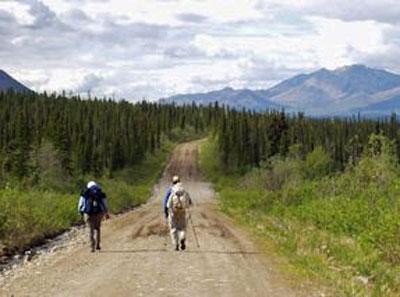Wrangell-St. Elias National Park and Preserve's 13.2 million acres include some outstanding scenery and wilderness opportunities, but until recently, there have been no formal NPS camping facilities in the park. That's now changed after the dedication of the new Kendesnii Campground.
The park is "bigger than the country of Switzerland," and stretches from the ocean to one of the tallest peaks in North America, Mount St. Elias (18,008). Most of the area is dedicated to backcountry and wilderness, and unlike many other large parks, Wrangell-St. Elias has not offered formal NPS campgrounds or concessionaire lodging.
Until last week, many visitors who wanted to camp used primitive sites on public land along the McCarthy and Nabesna Roads. There are also commercial businesses along area highways and on private land within the park boundaries that offer a variety of visitor services, including camping and lodging.
Now, visitors who'd prefer to use a designated NPS camping facility can take advantage of the new Kendesnii Campground, but rest assured, the park hasn't "gone urban."
The new camping area, located at Mile 28.2 on the Nabesna Road, has vault toilets, picnic tables, and ten sites that will accommodate tents and up to medium-sized recreational vehicles. There is no currently no charge for use of the site. A canoe launch and water well are also planned for Kendesnii.
The new facilities were dedicated under sunny skies on July 27 with a naming ceremony and picnic. Park Superintendent Rick Obernesser opened the event, saying “I am excited that so many of us are here today as we dedicate the park’s first official campground.”
A park spokesperson explains that "Kendesnii is the Ahtna name of Daisy Nicolai. She and her children had a spring camp in the campground area for many years. In addition to acknowledging the family’s connection to this site, using an Ahtna name for the campground recognizes the important association between Alaska Natives and Wrangell-St. Elias."
The park staff worked with local tribes in identifying the campground name, and the Cheesh’na Tribal Council, on behalf of Daisy’s family, partnered with the park in organizing the dedication. Many of the more than 100 guests at the event were members of Daisy’s family. Also among the guests were Nabesna Road residents and park visitors camping at the site.
Daisy’s closest surviving relatives – a sister and three daughters – shared memories of Daisy, as did several grandchildren. Speaking on behalf of the Cheesh’na Tribal Council, Tribal Administrator Wilson Justin, who is also one of Daisy’s grandchildren, said, “The honor of keeping a promise made a generation ago is a privilege not always understood but vital to those who stand in shadows of our Traditions. Thank You to the Wrangell-St. Elias National Park for the support in keeping that promise. Cheesh’na extends a welcome to all visitors to the Kendesnii Campground.”
If a visit to the park and use of the new camping area is in your future, some advance planning is in order, and the park website includes useful information about the Nabesna Road:
"This 42-mile gravel road from Slana to Nabesna traverses the headwaters country of the Copper and Tanana drainages. It is a dusty, gravel, dead-end road that is short on services but big on wilderness! The Nabesna Road offers Wrangell-St. Elias National Park and Preserve visitors a unique opportunity to explore interior Alaska. The drive is an adventure in the midst of the Wrangell, Mentasta and Nutzotin Mountains. Camping, hiking, wildlife viewing, fishing and hunting are just a sampling of the activities available just off of the road."
"The Nabesna Road was originally built in 1933 by the Alaska Road Commission to supply Nabesna Mine and to ship out its ore. Today, the Alaska Department of Transportation maintains the Nabesna Road and, generally, the road is passable by most two-wheel-drive vehicles. However, higher clearance and/or four-wheel drive are occasionally needed beyond Mile 29 due to stream crossings. Wet conditions such as spring run-off and heavy rain can make these stream crossings impassable. The last four miles of the road are not maintained and may be deeply rutted and wet. Vehicle travel on this portion of the road is not recommended."
You'll find additional information to help plan a visit to Wrangell-St. Elias on the park website.


 Support Essential Coverage of Essential Places
Support Essential Coverage of Essential Places







Comments
This is great! We love this park and glad to see it getting some love while keeping the wild in wilderness.